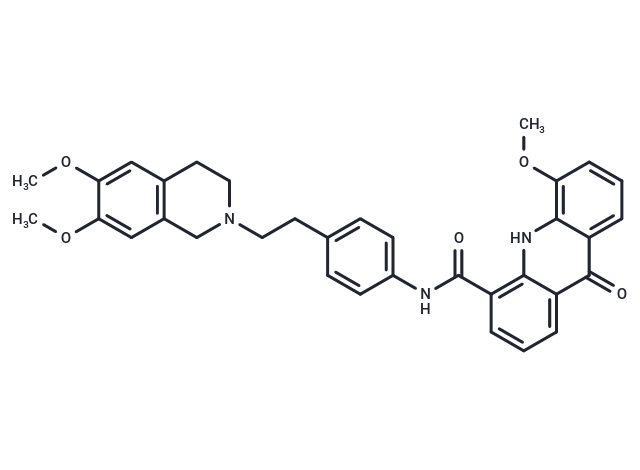Shopping Cart
- Remove All
 Your shopping cart is currently empty
Your shopping cart is currently empty

Elacridar (GG918) is a potent inhibitor of P-glycoprotein and BCRP.

| Pack Size | Price | Availability | Quantity |
|---|---|---|---|
| 5 mg | $35 | In Stock | |
| 10 mg | $57 | In Stock | |
| 25 mg | $109 | In Stock | |
| 50 mg | $198 | In Stock | |
| 100 mg | $297 | In Stock | |
| 200 mg | $497 | In Stock | |
| 500 mg | $793 | In Stock | |
| 1 mL x 10 mM (in DMSO) | $52 | In Stock |
| Description | Elacridar (GG918) is a potent inhibitor of P-glycoprotein and BCRP. |
| In vitro | METHODS: MCF-7, Caki-1 and 786-O cell lines were treated with Elacridar (GG918) (5 μM, 24 hours). Cell lysates were prepared and loaded into each well. Protein expression was determined by immunoblotting. β-actin expression was detected to normalize the total protein load. RESULTS Elacridar (GG918) affected the expression levels of P-glycoprotein and ABCG2 proteins in MCF-7 and 786-O cell lines; and affected the intracellular accumulation of Tc-MIBI in MCF-7 and 786-O cells. [2] |
| In vivo | METHODS: Elacridar (GG918) was administered to FVB wild-type mice in three different ways (2.5 mg/kg, intravenous injection; 100 mg/kg, intraperitoneal injection; 100 mg/kg, oral administration) to study the pharmacokinetic parameters of Elacridar (GG918) in plasma and brain. RESULTS The pharmacokinetic parameters of Elacridar (GG918) in plasma and brain were different in the three administration METHODS: the half-life in plasma after intravenous administration was 4.4 hours, in brain was 1.5 hours, and the Kp value was 0.82; the half-life in plasma after intraperitoneal injection was 4.3 hours, in brain was 9.2 hours, and the Kp value was 0.48; the half-life in plasma after intraperitoneal injection was 20 hours, in brain was 16 hours, and the Kp value was 4.31. [1] |
| Kinase Assay | Photoaffinity radiolabeling of P-gp: 10 μL of unlabeled cell membrane suspension (at 0.4 mg of protein/mL) are aliquoted into each well in 96-well plates. 5 μL of GF120918 are then added to each well. The plate is incubated 25 min at 25℃ in the dark. 5 μL of tritiated azidopine (1.8 TBq/mmol) (0.6 μM in HCI 0.2 mM) are added to each well. After 25 min of incubation at 25℃ in the dark, samples are simultaneously irradiated for 2 min at 254 nm at 0℃ with a thin layer chromatography-designed UV lamp directly in contact with the plate. Samples are solubilized in sodium dodecyl sulfate-polyacrylamide gel electrophoresis sample buffer but not heated. After separation on a 7.5% polyacrylamide gel, the gel is treated for fluorography with Amplify and exposed during 3 days onto a photosensitive film. The fluorography is analysed using a Camag thin layer chromatography Scanner II densitometer. |
| Cell Research | 3.0×103 cells per well are seeded in a 96-well plate. After 24 h incubation, an optimum concentration gradient of elacridar is added to each well. After culturing for 48 h, cell viability is assessed using the proliferation reagent, MTT. Control cells are treated with the vehicle only, 0.1% DMSO. After this ?nal incubation, the medium is aspirated and precipitated formazan crystals are dissolved in DMSO (100 μL/well). The absorbance of each well is measured at 540 nm, and a reference wavelength of 650 nm is read with a multiskan JX microplate reader. Cell viability is calculated as percentage of the control value. (Only for Reference) |
| Alias | GW120918, GW0918, GG918, GF120918 |
| Molecular Weight | 563.64 |
| Formula | C34H33N3O5 |
| Cas No. | 143664-11-3 |
| Smiles | COc1cc2CCN(CCc3ccc(NC(=O)c4cccc5c4[nH]c4c(OC)cccc4c5=O)cc3)Cc2cc1OC |
| Relative Density. | 1.264 g/cm3 (Predicted) |
| Storage | store at low temperature,keep away from direct sunlight,keep away from moisture | Powder: -20°C for 3 years | In solvent: -80°C for 1 year | Shipping with blue ice. | ||||||||||||||||||||
| Solubility Information | Ethanol: < 1 mg/mL (insoluble or slightly soluble) H2O: < 1 mg/mL (insoluble or slightly soluble) DMSO: 7.86 mg/mL (13.95 mM), Sonication is recommended. | ||||||||||||||||||||
Solution Preparation Table | |||||||||||||||||||||
DMSO
| |||||||||||||||||||||

Copyright © 2015-2025 TargetMol Chemicals Inc. All Rights Reserved.